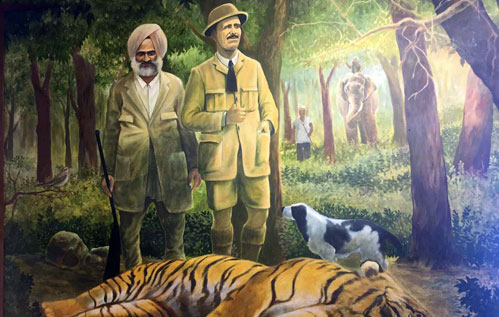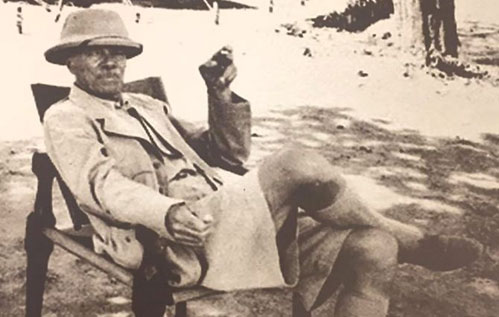
Jim Corbett Still Lives Here
A sloping tin roof shades Jim Corbett's bust from the sun and the rain. Set in the garden of a stately bungalow which was Corbett's winter home in Kaladunghi, Uttarakhand, the bungalow turns 100 next year. It is now a museum chronicling his life; but is still known as Jim Corbett's house. Edward James Corbett, the Nainital-born conservationist and naturalist was known to hunt man-eating tigers/leopards alone and on foot. The only condition he laid was that the reward for the hunt be cancelled before he set out. He hunted to protect people from falling prey to maneaters and believed in conserving India's wildlife. It was an ode to his deep love for the jungles that the first tiger reserve under Project Tiger set up to protect the national animal in 1972, among the forests he knew so well was named after him. India Post issued a commemorative stamp on his 100th birth anniversary in 1975. Corbett bought 40 acres of land for Rs 1,400 next to the Kaladunghi bungalow in 1915 and christened it Choti Haldwani. He let it out to a few villagers and converted it into a model village by building houses for tenants, constructing irrigation channels and a boundary wall for protection against wild animals.
When he left India and moved to Kenya in 1947, he sold the Kaladunghi bungalow to a merchant, but did not sell Choti Haldwani. Instead, he generously distributed the land among the tenants. When a panchayat bhavan was to be constructed in the village post-Independence, Corbett made a contribution of Rs 1,000 towards it from Kenya. Corbett also gifted some part of the Choti Haldwani land to the forest department which housed quarters for forest rangers. Another gift to the Ramnagar forest division was his motor car. In a letter to businessman Jagat Narain displayed in the museum, Corbett mentions detailed amounts to be given as donations to temples and the poor. The museum has several letters written by Corbett from his home in Nyeri, Kenya, which includes correspondence with government officials and friends in India.
The Kaladunghi bungalow was purchased by the department of forest in 1965 and turned into a museum dedicated to Corbett's life. Corbett wrote most of his five books at this bungalow where he returned to live after serving in World War I and the Railways. In a letter written from Kenya in 1951 which is part of the display at the museum, he writes that the third part of the book My India is about how he started life in the country of his birth. 'It was a hard life, but I enjoyed every day of it,' wrote Corbett. The book also included stories about the 'heroic deeds of India's humblest and poorest sons,' he said. The last line of a plaque bearing his life sketch in the museum says 'Corbett today is an icon synonymous with wildlife and nature conservation.'

Last week, Union Minister of State for Environment and Forest Ashwini Kumar Choubey suggested that Jim Corbett's name be removed and the national park be renamed the Ramganga National Park. During the time Corbett lived in present day Uttarakhand, the park was called Hailey Park after Malcolm Hailey, the governor of then United Provinces.
It was India's first national park started in 1936 where Corbett played an important role. In a letter to the divisional forest officer from Kenya in 1948, Corbett had said he wanted to take pictures of tiger and leopard pug marks in Hailey Park on his next visit. He could never make that trip.
The park was renamed Ramganga post-Independence after a river running through the forest. The name was changed to the Jim Corbett National Park in 1957, two years after Corbett's death in Kenya. It was a befitting tribute to a man who loved and knew the tiger and its habitat like few did. 'The tiger is a largehearted gentleman with boundless courage and when he is exterminated -- as exterminated he will be unless public opinion rallies to his support -- India will be the poorer by having lost the finest of her fauna,' Corbett said.
A board saying the above is among the first things you will encounter when you visit the Corbett Museum.

Corbett was the son of a Meerut-born English army man who sold medicines to the horse artillery regiment. As a boy, Jim learned to stalk, use the direction of the wind to mask his scent and walk the jungle in silence. He shot his first man-eater in 1907 by killing the tigress of Champawat that had taken 436 human lives. He shot the man-eating leopard of Rudraprayag in 1927. The leopard killed around 124 humans. Villagers used to approach him to free them from the terror of wandering man-eaters. It would take days of trekking in the mountains and required immense patience. Corbett is believed to have slayed 50 man-eating tigers and 250 leopards. He shot his last man-eater at 71. He was also a taxidermist who skinned and stuffed animals. A keen wildlife photographer, he was among the first to use a movie camera to capture the wild. He would use the footage to educate villagers about wildlife. After completing secondary education, Jim Corbett joined the Bengal-North Western Railway at 17 and served for 21 years in Mokamah ghat and Samastipur in Bihar. He would return to Kaladhungi and Nainital during holidays and killed three maneaters during that time. He served in the First World War as a captain and was sent to Waziristan and Afghanistan in 1917. During World War II, the British gave him special appointment to train soldiers in the ways of the jungle. Corbett understood the language of a forest, the nuances of a tiger's brain and could think like the tiger he followed, noted conservationist Valmik Thapar 'There is no one in India today who has that talent that Corbett had,' says Thapar
India only had 1,800 tigers in 1972 when Project Tiger began in the Corbett Tiger Reserve. Today, the park has 231 tigers, the largest population of tigers in India. With his name or without -- nothing would have made Corbett happier.